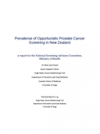This paper quantifies the prevalence of opportunistic prostate cancer screening in New Zealand in 2008.
Purpose
This project was undertaken to describe the prevalence of, and factors associated with, opportunistic screening for prostate cancer using PSA tests in primary care in New Zealand.
Methodology
- Male participants were randomly selected from the general electoral rolls and had to be aged between 40 and 74 years old. The samples were weighted towards Māori who were selected on the basis of a positive Māori ancestry listed on the general electoral rolls.
- Questionnaires were mailed to participants, and if no reply was received they were contacted by telephone. Trained interviewers conducted all telephone interviews using the standard questionnaire.
- Educational attainment was categorised by highest qualification gained. Main occupations before retirement were recorded. Socioeconomic status was categorised from a high of 1 to a low of 6 according to occupation using the New Zealand Socioeconomic Index of Occupational Status.
- A medical history score was derived from responses to enquiry about cardiovascular disease, cerebrovascular disease, diabetes and cancer. Participants with the larger scores had more adverse medical histories. Smoking history was collected with ‘ever smokers’ defined as having smoked more than one cigarette a day for a year or more. As DHBs areas were too small for useful statistical analysis, Transitional Health Authority (THA) areas (Northern THA: Auckland and Northland; Midland THA: Waikato, Bay of Plenty, Lakes, Tairawhiti, and Taranaki; Central THA: Hawkes Bay, Manawatu, Wanganui, Wairarapa, Wellington, Porirua, Kapiti, Nelson, Marlborough, and Chatham Islands; Southern THA: all South Island except Nelson and Marlborough) were used instead. The THAs were assigned from domicile codes on the electoral rolls. Symptom histories for 2008 and the previous 5 years were collected. These included lower urinary tract symptoms (LUTS; dysuria, nocturia, frequency, urgency, not emptying bladder completely, incontinence, weak urine stream, hesitancy and haematuria) and other symptoms possibly suggestive of prostate cancer (haematospermia, erectile dysfunction, unexplained severe bone pain, unexplained weight loss).
- For some analyses LUTS were grouped into 3 categories; no symptoms, 1 or 2 symptoms, or 3+ symptoms. Verification of self-reports of prostate disease or a family history of prostate cancer were outside the scope of this study.
- In addition to ever having had a PSA test, four further PSA test outcome variables covering 2 different time periods (in 2008 or in the 5 years prior to 2008 i.e. 2003-2007) were collected.
- First, any PSA test included a test ordered or taken by a general practitioner, a nurse, or urologist or other specialist.
- Second, a PSA test in primary care excluded PSA tests taken or ordered by urologists and other specialists, or their nurses.
- Third, a screening PSA test in primary care (without LUTS) only included PSA tests that were part of a general or annual check-up, a request for a test by the patient although they had no problems, or a recommendation for a test by a doctor although the patient reported no problems.
- Fourth, a screening test in primary care (with or without LUTS) included the previous category plus men who had a PSA test after presentation with LUTS. PSA tests taken after the patient presented with haematospermia, unexplained severe bone pain, unexplained weight loss or erectile dysfunction were excluded from screening PSA tests as they were considered to be possible symptoms of prostate cancer. All PSA tests taken in patients for follow-up after a urological operation or after a diagnosis of prostate cancer were not considered to be screening PSA tests.
- All statistical tests were done using Stata 10.
- All ‘don’t know’ responses and missing values were excluded from analyses unless otherwise stated. Crude, and age-adjusted proportions were calculated using 5-year age groups and the WHO standard population aged 40-74 years. Comparison of crude proportions within groups of categorical variables was carried out using Pearson's χ2 test. The 95% confidence intervals for adjusted proportions were calculated. A binomial linear regression model was fitted to examine univariate and multivariate associations of factors with PSA test outcome variables. This model generated risk ratios that are interpretable as relative risks. Men with prostate cancer were excluded from regression models. Tests for trend in adjusted relative risks were done across continuous variables or ordered categories
Key Results
The consent rate was 78% in non-Māori men and 73% in Māori men. 49% of participants had ever had a PSA test. 18% of participants had a screening PSA test (without LUTS) in primary care in 2008 and 22% had had a screening PSA test (without LUTS) in the previous 5 years. Most PSA tests taken in primary care were taken in asymptomatic men. 50% of non-Māori participants had ever had a PSA test compared to 47% of Māori. 29% of Māori participants and 21% of non-Māori men reported visiting a doctor because of urological symptoms between 2003 and 2008. 67% of Māori men in the Southern region reported a previous PSA test; significantly more than other THAs.

